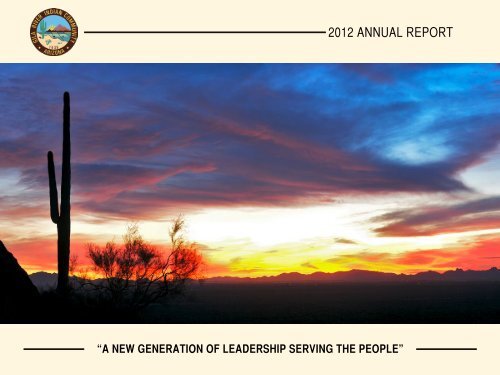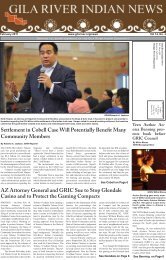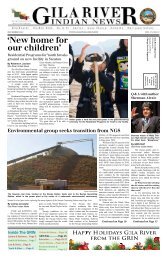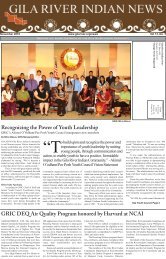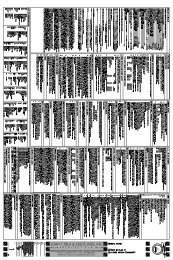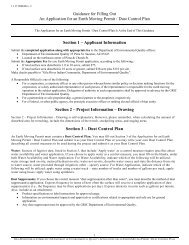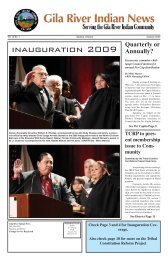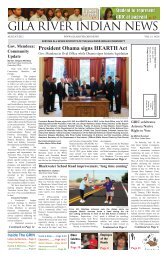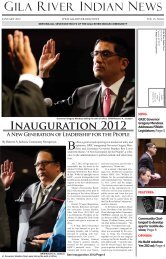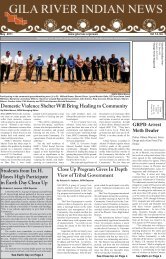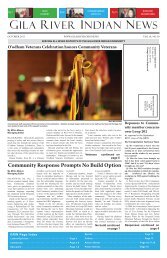View annual report by clicking here - Gila River Indian Community
View annual report by clicking here - Gila River Indian Community
View annual report by clicking here - Gila River Indian Community
- No tags were found...
Create successful ePaper yourself
Turn your PDF publications into a flip-book with our unique Google optimized e-Paper software.
2012 ANNUAL REPORT“A New Generation of Leadership Serving the People”
Governor’s MessageDear <strong>Gila</strong> <strong>River</strong> <strong>Indian</strong> <strong>Community</strong> Members andFriends,Executive Management TeamI am pleased to share with you, the “<strong>Gila</strong> <strong>River</strong><strong>Indian</strong> <strong>Community</strong> 2012 Annual Report.” This<strong>report</strong> reflects a snapshot of progress achievedtoward the Vision for the future of the <strong>Gila</strong> <strong>River</strong><strong>Indian</strong> <strong>Community</strong> that Lieutenant Governor Lewisand I shared with you when we took office just overa year ago. This Vision was a future of stewardship,of creating long-term prosperity for our people <strong>by</strong> finding ways to prepare our<strong>Community</strong> to meet the demands of the future while balancing the demands ofgrowth.Our Vision was embodied in a Plan that described 12-Initiatives that you, themembers of the <strong>Gila</strong> <strong>River</strong> <strong>Indian</strong> <strong>Community</strong>, told the Lieutenant Governor andme that you wanted us to focus upon as your elected leaders. The Initiativesaddressed four-important areas: our Government, our <strong>Community</strong>, our People,and our Growth. We then consulted with our Administration and created 100-day and 1-year Action Plans that took demonstrable and concrete actions towardachieving progress in each of the 12-Initiatives. Our Transition Action Plan wascommunicated to the <strong>Community</strong> Council and distributed to <strong>Community</strong> memberslast April 2012.Since that time, we have been busy implementing and making progress in each ofthe 12-Initiatives, those things that you told us were important to you. Now, thatwe have the benefit of a year behind us, I am pleased to share with all of you newsabout the work that has been done, data that has been considered, and the resultsthat have been accomplished. I would like to take the time to share with you someof the challenges that we continue to confront and the work that the LieutenantGovernor and I, the <strong>Community</strong> Council, and the Administration will undertakein 2013 to continue making progress in each of the 12-Initiatives while we focuson four-special interest areas (Housing, Tribal Socials Services, Education, andViolence Prevention) as well as promote self-sufficiency to empower <strong>Community</strong>members to take positive steps to improve their lives and contribute to the overallgrowth and success of the <strong>Gila</strong> <strong>River</strong> <strong>Indian</strong> <strong>Community</strong> in partnership with yourelected leadership.L to R: Kimberly Dutcher, Division Manager; Nada Celaya, Division Manager;Stephen Roe Lewis, Lt. Governor; Gregory Mendoza, Governor; David White, <strong>Community</strong>Manager; Michelle Bowman, Division Manger; Absent: Noel Hoover, Division Manager<strong>Community</strong> CouncilTop row L to R: Franklin Pablo Sr. (D5), Jewel Whitman (D2), Terrance Evans (D6),Dale Enos (D3), Myron Schurz (D3), Barney Enos Jr. (D4), Christopher Mendoza (D4),Albert Pablo (D6), Arzie Hogg (D1), Anthony Villareal Sr. (D6),Bottom row L to R: Janice Stewart (D5), Jennifer Allison (D4), Monica Antone (D4),Annette Stewart (D5), Brenda Robertson (D5), Martha Miller (D7), Cynthia Antone (D1)2
Workforce DemographicsThe <strong>Gila</strong> <strong>River</strong> <strong>Indian</strong> <strong>Community</strong>’s workforce has had an overall abundanceof growth from 2007 to 2012, increasing the enrolled <strong>Community</strong> memberemployment rate <strong>by</strong> 26.6% and the combined overall growth rate of 29.1% forNative American employees. It is this positive growth that has propelled the<strong>Community</strong> to increase employment opportunities for enrolled <strong>Community</strong>members and continue strengthening the <strong>Community</strong>’s prosperity throughknowledge, education and experience for the future.Fiscal Year <strong>Community</strong> Members Percent Native American Percent Other Percent Total 2007 718 46% 308 20% 538 34% 1564 2008 896 45% 415 21% 703 35% 2014 2009 948 46% 429 21% 699 34% 2076 2010 894 44% 412 21% 707 35% 2013 2011 803 43% 390 21% 690 37% 1883 2012 909 45% 416 21% 700 35% 2025 Summary of ServicesExecutive DivisionThe Executive Division is characterized <strong>by</strong> a diversity of administrativeoffices, special interest and advisory groups, and direct service providers.The Office of the <strong>Community</strong> Manager, Communication & Public AffairsOffice and the Management Information Systems Department provide directsupport to the Executive Office in carrying out the day-to-day activitiesassociated with the tribal government. The Youth Council and the Council ofElders provide information and advice to the Executive Office on constituentmatters for policy development consideration. The Defense Services Officeprovides services to <strong>Community</strong> members, who otherwise might not haverepresentation in legal defense matters.Administrative Support DivisionThe Administrative Support Division also consists of a diverse groupingof administrative offices, departments, and programs that provide servicesto other administrative units and <strong>Community</strong> members. The acquisition ofhuman resources and pertinent goods and services under this division providesthe necessary resources to sustain government operations. Education,job placement, and training are critical services necessary to develop theworkforce and enrich the lives of <strong>Community</strong> members. Housing continuesto be an important issue for leadership and the <strong>Community</strong> HousingDepartment has been placed under this division to provide greater oversightand productivity in meeting the various housing needs of <strong>Community</strong>members.Public Safety DivisionThe Public Safety Division consists of a functional grouping of firstresponders and service providers, who perform emergency and socialservices for <strong>Community</strong> members. This division must be prepared to reactto any type of disaster or emergency situation at any time. Consequently,personnel, equipment, training, and facilities have undergone or are goingthrough assessments to determine the appropriate level of resources neededfor each service activity. In addition, increasing trends in criminal activityand violence, and new mandates, such as the Tribal Law and Order Act will3
place additional demands on division personnel and facilities. This divisionis actively engaged in preparing and recruiting <strong>Community</strong> members forcareers in public safety.Tribal Development Services DivisionThe Tribal Development Services Division serves many functions fromproviding planning, engineering, and construction services to providingdirect services to <strong>Community</strong> members through the District Service Centers,recreation facilities, and the library. This division serves the needs of theelderly through the Elderly Services and Elderly Nutrition departments,and plans and manages the <strong>annual</strong> Mul-Chu-Tha fair. From constructinghouses to roads and new governmental facilities, this division is responsiblefor developing and maintaining the infrastructure needed to support growthwithin the <strong>Community</strong>. This is the largest unit within the tribal administrationdivisional structure.Natural and Cultural Resources DivisionThis division consists of a functional grouping of organizational unitscharged with protecting and preserving the natural and cultural resourcesof the <strong>Community</strong>. It exercises this responsibility through enforcementprovisions contained in various ordinances, policies, resolutions, <strong>by</strong>laws,and procedures authorized <strong>by</strong> the <strong>Community</strong> Council. In addition toproviding services for internal stakeholders, certain components of thisdivision are often called upon to provide consultation services for outsideinterests. The Huhugam Heritage Center is the most recent addition to thisdivision and efforts are underway to develop the facility into a full servicecultural activity center as it was originally intended.Office of the Treasurerof all funds, investments and assets of the <strong>Community</strong>. The Gaming InternalAudit Department ensures compliance with all Federal, State and Tribalregulations and ordinances. Revenue/Internal Audit ensures all <strong>Community</strong>departments and enterprises are in compliance with any Federal, State andTribal regulations and ordinances and grant requirements and maintainadequate internal controls. The Per Capita Office administers the per capitaprogram for the <strong>Community</strong> and provides oversight of the minor trusts. ThePension Administration oversees the <strong>Community</strong>’s pension plan and ensurespayments are made.<strong>Community</strong> Council Secretary’s OfficeThe <strong>Community</strong> Council Secretary’s Office (CCSO) provides administrativesupport to the seventeen (17) <strong>Community</strong> Council members and to the seven(7) Standing Committees of the <strong>Community</strong> Council. CCSO maintains theordinances, policies, resolutions, <strong>by</strong>laws, and any procedures authorized<strong>by</strong> the <strong>Community</strong> Council; upon written request provide this informationto departments, entities and community members. The Tribal ElectionsProgram and Voter Registration Board are under the direction of CCSO.Unassigned DepartmentsUnassigned departments are currently not part of the tribal administration’sdivisional structure; however, these departments, activities, and programsprovide essential services to the <strong>Community</strong> Council, Executive Office, and<strong>Community</strong> members. In addition to essential services, such as the Office ofthe General Counsel, the Office of the Prosecutor, and the Executive Office,this budget category supports various activities and functions through grantfunding. Legal services, donations, urban members, the Boys and GirlsClubs, and Veterans organizations are all recipients of grant funding. TheTribal Courts are also funded under this budget category.4The Office of Treasurer is comprised of the <strong>Community</strong> Treasurer and staff,Finance Department, Revenue/Internal Audit Department, Gaming InternalAudit, Per Capita Office and Pension Administration. It is the Office ofTreasurer’s mission to insure and protect the integrity of the <strong>Community</strong>’sfunds, investments, and assets. The Office of Treasurer oversees the<strong>Community</strong>’s investments and overall finances of the <strong>Community</strong>. TheFinance Department ensures the accurate accounting in the books and records
Our Government—Initiatives1. Financial StabilityIn addition to the current state of the national economy, the recent federalbudget agreement to forestall the “fiscal cliff” has caused many state, local,and tribal governments to analyze the impacts of potential reductions oreliminations in federal subsidies. Because federal grants account forapproximately 20 percent or our <strong>annual</strong> budget revenues, any changes tothis funding stream would most likely have an impact to the delivery ofcertain programs and services provided within our <strong>Community</strong> (i.e. HeadStart, etc.). Because of these fiscal uncertainties, we must continue toexercise prudent management of our financial resources to ensure ourfinancial stability and ability to sustain our way of life for generations tocome.By establishing budget priorities, exploring alternative fundingmechanisms, and promoting economic development, we are committedto improving transparency and efficiency in fiscal matters as responsiblestewards of our financial resources.1-Year Accomplishments•Conducted four-public outreach meetings on budget policy, process, andplanning factors for <strong>Community</strong> member information and input•Incorporated key education and community service projects (such Head Startfacilities at Districts 4-6, service centers at Districts 2 and 5, and Youth Home) aspriority projects for capital budget•Developed plan to relocate several administrative departments to the formerBeaudry RV facility as a cost-effective approach to reduce the capital outlay foradditional office space, warehouse space, and a fleet facility while consolidatingkey services•Developed training program on “Cost Principles for State, Local, and TribalGovernments” to address management of federally-funded programs consistentwith the recent shift to bottom line budgeting at the division-level•Provided assistance to departments in the grant submittal process resulting inaward of over $3.6 Million in grant funding for past year100-Day Accomplishments•Developed information and training program to assist with the grantsubmittal process and incorporated grants as a key planning factor in theformulation of the <strong>annual</strong> budget•Received Notice of Award for over $3 Million for WIA innovation grantto support the development of the Career Pathways system to enhance jobselection, training, and placement for <strong>Community</strong> members•Supported in-house training with certified instructors and throughpartnerships with other public safety departments to provide training forPolice Department at reduced costs•Implemented measures to reduce overtime costs for Fire Department•Convened work session and strategized with tribal leadership and<strong>Community</strong> Treasurer on goals and timelines for development of FY2013<strong>annual</strong> budgetChallenges•Limited resources to address growth after savings, per capita, and housingallocations•Limited planning horizon and high competition for capital budget5
2. Tribal Consultation100-Day Accomplishments1-Year Accomplishments6As with President Obama’s first term in office, we may expect continueddialogue and engagement in consultation polices with his administration tofurther strengthen the government-to-government relationship between theUnited States and tribal governments to improve the quality of life for allAmerican <strong>Indian</strong>s and Alaska Natives.As a stakeholder in various initiatives and legislative efforts, we mustcontinue to actively participate in tribal consultation and related activitiesat all levels of government. T<strong>here</strong>fore, we stand committed to engage withboth existing and new partners to develop a proactive approach to tribalconsultation that ensures the continued delivery of quality programs andservices to <strong>Community</strong> members.•Participated in tribal consultation with three Arizona universities todevelop policy and protocols for university research with tribal nations•Consulted with District Service Centers on health prevention strategies for<strong>Community</strong> members with special emphasis on elderly nutrition•Continued coordination with U.S. Census Bureau to ensure <strong>Community</strong>participation in gathering of census data on a regular basis•Maintained dialogue and strengthened relationship with FEMA, State, andlocal agencies to enhance Emergency Management•Actively participated in the consultation process established <strong>by</strong> the U.S.EPA for proposed changes to federal legislation•Participated in the assessment of IHS/638 Waiver and impact to HealthResources Department•Convened Task Force to assess impacts and provide information to<strong>Community</strong> members on implementation of Tribal Law and Order Act(TLOA)•Continued coordination and intergovernmental agreements with BIA,FHWA, ADOT, and MCDOT for various roadway projects, including the$8.5 Million SR 87 Highway Improvement Project•Met with City of Chandler to discuss proposed changes for Lone ButteWastewater Treatment Plant•Provided 248-formal responses to various federal and state agencies in mattersrelating to Off-Reservation projects involving cultural resources•In association with Pinal Partnership, the Executive Office/OCM co-hostedthe final debate between the two-leading U.S. Senate candidates for the Stateof Arizona: Republican Rep. Jeff Flake and Democrat Richard Carmona. Theevent was held at the Whirlwind Golf Club (Shelde Building) and was attended<strong>by</strong> over 200-participants. Lt. Governor Stephen R. Lewis provided the welcomeand opening remarks, and acknowledged the partnership, various state andlocal officials, and members of the GRIC <strong>Community</strong> Council. The debatewas moderated <strong>by</strong> a local television news show host (Brahm Resnik, 12 News)and recorded for future reference/file footage, which was broadcast <strong>by</strong> localmedia outlets. The debate served to showcase the <strong>Community</strong>, its leadership, itsengagement in national and local politics, and its quality hospitality venues in apositive light.Challenges•Limited human resources dedicated to tribal, state and federal consultationactivities•Improved coordination among leadership, stakeholders and consultants
3. CommunicationsWhile the <strong>Community</strong> has various media outlets at its disposal, such asthe Internet, newsprint, and internal video broadcasting, t<strong>here</strong> are stillchallenges associated with delivering timely, effective, and consistentcommunications to all <strong>Community</strong> members and other internal andexternal stakeholders on matters of importance.We will continue to work at maximizing our communications capability <strong>by</strong>coordinating and improving our processes, and providing regular updatesthrough various media outlets, including social media.•Completed redesign of <strong>Community</strong> Internet web pages•Participated in and supported the following public relations activities:oTrade Show booth at the United National <strong>Indian</strong> Tribal YouthConference 2012oArizona Tourism ConferenceoNCAI Conference and Trade Show boothoNative Vote Outreach and Phone BankoEmployee Round UpoEstablished monthly public relations meetings with corporations,entities, and/or agencies of the <strong>Community</strong>100-Day Accomplishments•Executive Office initiated monthly work sessions with the <strong>Community</strong>Council to improve communications on matters of importance to triballeadership•Executive Office reemphasized existing communications protocol topreserve confidentiality in matters pertaining to employee actions•Tribal Education Department initiated communications protocol for alleducation service providers On- and Off-Reservation•Distributed Transition Plan to <strong>Community</strong> members and employees•Increased efforts to provide TERO job information to <strong>Community</strong>members <strong>by</strong> using Intranet, flyers, attending meetings, and performingoutreach1-Year Accomplishments•Over the 200-day period between June 1, and December 15, 2012, t<strong>here</strong>have been a total of 805 likes and 69 unlikes on the GRIC Facebook Pageaveraging approximately four new followers of the page per day•In addition to creating more efficiency in the production of the <strong>Gila</strong><strong>River</strong> <strong>Indian</strong> News (GRIN), news features and highlights included:establishment of the GRIN KIDS section, the production of the Prop 202/AIGA video, an interview with Sherman Alexie at Dobson High School,and coverage of Carmona-Flake debate at Pinal Partnership that was hostedat the Shelde Building•Transition of the management of Intranet content from the MISDepartment to CPAOChallenges•Lack of Intergovernmental Liaison has made it difficult to establish andmaintain a strong government-to-government relationship with localgovernments and municipalities that border our <strong>Community</strong>7
4. Protect and Promote SovereigntyWe continue to effectively exercise our sovereignty <strong>by</strong> making ourown choices and decision regarding current and future issues facing the<strong>Community</strong>, and <strong>by</strong> electing wise leadership, who are committed to worktoward a prosperous and healthy future for all <strong>Community</strong> members.We must continue to foster an internal governmental environment thatpromotes commitment to the best interests of the <strong>Gila</strong> <strong>River</strong> <strong>Indian</strong><strong>Community</strong>; unifies commitment among all decision makers enablingcooperation toward achievement of agreed upon goals and objectives;and educates our people on tribal, state, and federal affairs to promote aninformed citizenry actively engaged in decision making.100-Day Accomplishments1-Year Accomplishments8•Adopted and promoted Transition Plan for new administration•Provided quality legal representation and protection of clientConstitutional rights through services provided <strong>by</strong> Legal Defense ServicesOffice•Promoted education on the importance of sovereignty through YouthCouncil participation in Close Up event•Established framework for the Culture Curriculum and requirementsfor certification of Cultural Teachers for integration into our educationalsystem•Exercised sovereignty through the State Revenue Sharing programw<strong>here</strong><strong>by</strong> the <strong>Community</strong> decided on w<strong>here</strong> and how a portion (over $2.5Million) of our mandated revenue sharing would be spent•Continued TERO effort to educate contractors and employees on triballaws, ordinances, and policies relative to <strong>Community</strong> preference andNative American preference in employment•Explored alternative enrollment eligibility criteria to sustain integrity toPima and Maricopa bloodlines•Developed a pre-determined process for a Governor’s Declaration atthe initiation of a Stafford Act Presidential Declaration in the event of anemergency•Attended White House meeting with senior administrative staff to discuss issuesand bring about awareness to the obstacles that hinder the procurement andspending of IHBG fundsChallenges•Effective and ongoing dialogue between Executive Office and <strong>Community</strong>Council that promotes unity on issues affecting the <strong>Community</strong>’ssovereignty•Engage stakeholders, including <strong>Community</strong> leadership, <strong>Community</strong>Courts, special task forces and other to coordinate effective sovereigndecision making
Our <strong>Community</strong>—Initiatives5. Health CareWe must continue to support and strengthen our health and aftercareprograms while striving to provide the highest quality of health careservices to <strong>Community</strong> members and members of other Native Nations.We must also address mental health and diabetes prevention programs.•Provided assistance and promoted Block Watch and Domestic Violenceprograms through DCH•Improved working relationship through CSD with <strong>Gila</strong> <strong>River</strong> Health Carein providing service for dialysis patientsBy using a collaborative approach to our health care systemthat involves all of our health care providers, we can develop aunified plan to improve health care service delivery to <strong>Community</strong>members and members of other Native Nations that we serve.100-Day Accomplishments•Executive Office championed and implemented an employee wellnessprogram, “Wellsteps”, to improve the health and well being of theworkforce•Executive Office announced plans for an Employee Picnic to improve themorale and wellness of the workforce•DEQ conducted environmental assessments at former industrial facilitiesw<strong>here</strong> potential environmental contamination may exist and recommendedremediation1-Year Accomplishments•Changed focus of CDC grant to engage in public health readinessactivities, complete a <strong>Community</strong> Health Assessment/Profile, a HealthImprovement Plan, and Strategic Plan•Amended current building specifications to incorporate more finishesand features that provide greater accessibility and support for <strong>Community</strong>members, who struggle with disabilities and other limitations•Developed Health and Wellness Performance Team to research andprovide resources and opportunities to improve firefighter health andmental wellness•Established a full-time position within the Police Department to review alldomestic violence investigations•Completed training through DCH on alcohol and drug abuse andawareness at several District Service CentersChallenges•Lack of dedicated Administration oversight of <strong>Community</strong> healthinitiatives•Continue to promote self-responsibility and individual wise decisionmaking among <strong>Community</strong> workforce and membership9
6. Housing 1-Year AccomplishmentsPrior to the Administration entering office, the <strong>Community</strong> Councilsegregated its housing programs, and created a new department, theDepartment of Housing Development (DHD) to operate the tribally fundedhousing programs. Working with the <strong>Community</strong> Council’s Housing TaskForce, (HTF) much of DHD’s work in 2012 focused on creating a newdepartmental framework from which to operate the new department. Ratherthan focusing on construction only, as was done in the past, DHD is expandingits role to include an asset management program to ensure the <strong>Community</strong>’ssignificant investment in housing infrastructure is sustained over time.DHD has also been engaged with the Finance Department and the Office ofthe Treasurer to improve the way in which planning and budgeting for newhousing projects is carried out. Some of these changes will be implementedin FY14. However, not all the work involved planning. As of December2012, DHD constructed and turned over 24 homes to <strong>Community</strong> members,while construction continues in various stages on another 62 homes.The Department of <strong>Community</strong> Housing (DCH) is responsible for the<strong>Community</strong>’s federally funded housing programs. DHD completed anumber of housing projects in the <strong>Community</strong> including several demolitionprojects in Districts 6 and 7 and renovation and reconstruction projects inDistricts 3, 4, 5, and 6. A total of sixty-nine (69) units were renovated lastyear. Some of the new construction projects also have a Crime Preventionand Safety Drug Elimination component that provided for landscaping andiron fencing. DCH also began planning work on a twenty unit ElderlyComplex to be located in District 4. Bidding on this project is set to beginin mid February.•Implement up-front planning processes for housing and associatedinfrastructure development•Develop a more comprehensive Quality Assurance Program to ensure thedesired quality of materials and construction methods are maintained•A draft Asset Management Plan to maintain and repair homes on the<strong>Community</strong>’s asset inventory has been completed with considerations toinclude warranty repair procedures, regular preventative maintenance,home insurance coverage and methods to address home occupant abuse100-Day Accomplishments•Significant progress made of new department through increased staff,expanded department responsibilities, including asset managementprogram, revised Home Benefit Program, and new financial and budgetsystem for FY2014•Construction of new homes continued; approximately 30 homes providedto <strong>Community</strong> members in 2012; with more under construction and 26more to be bid outChallenges•Addressing construction delays resulting from increased homeconstruction activity nationwide, which has resulted in a shortage of skilledlabor. None of this has been alleviated in the past month, but may presentadditional challenges as the economy improves and construction activity inthe region increases.11
7. Public SafetyPublic safety involves the prevention of and protection from events that couldendanger the safety of the general public from significant danger, injury/harm, ordamage, such as crimes, fires, or disasters. It is important to implement measuresto ensure public safety so that health and normal life is always maintained. Due tothis we will continue to take a comprehensive approach to improving public safetyand the quality of life for our <strong>Community</strong> members. <strong>Gila</strong> <strong>River</strong> has taken the firststep <strong>by</strong> passing the Tribal Law and Order Act.We will continue a collective approach to our public safety framework indeveloping a unified plan that will reduce its vulnerability to public safety threatsand issues.We must continue to implement planned improvements to public safety services.We will continue offsetting tribal dollars through alternative funding sources, suchas grants. We will continue participating in tribal consultation and establish newpartnerships to improve public safety and justice in our community.100-Day Accomplishments•Prepare, train, respond, and mitigate tragic events.•Ongoing MAG classes ensure education and training of employees onemergency preparedness.1-Year Accomplishments•Through increased staffing and strategic positioning of police resourcespolice response time has decreased.•Critical infrastructure in the <strong>Community</strong> has been identified. Next stepsinclude providing information on mitigation of potential incidents.•Collaborative effort with Housing and Police Department to keep peace insubdivisions and control crime.Challenges•Radio/Communication network•Human Resource policies and procedures do not cover 24/7/365 houroperations•Physical space – PD and Dispatch are housed in the DRS facility and havesince been outgrown. Criminal Investigations housed at Fire Station 429.K9 and BPU housed in Lone Butte. Graffiti Abatement housed in D1 FireStation. Need to find location to house CRT•Storage issues – PD equipment and vehicles•Storage issues – DRS in need of a climate controlled warehouse. Thiswill enable DRS to keep enough inventories on hand to meet the needs ofan ever changing population.•Physical space – TSS is using a substandard facility that provide nosecurity for staff or privacy for consumers•Database – TSS does not have a database•TSS - high case loads and ratio of children being investigated to staff•T<strong>here</strong> continues to be insufficient community placements for foster andadoptive families•Lack of a local Training Center for Public Safety12
8. Natural ResourcesWe are continuing to support the preservation and the protection of ourvaluable natural resources which include water, land, culture, plants,animals, air, land base protection, and restoration of traditional ways oflife. The management of our natural resources including the delivery anddistribution of services, managing staff and equipment, and the utilization ofthe best technology will ensure that we are providing the highest standardsof protection, preservation and conservation of our natural and culturalresources.100-Day Accomplishments•Continued to protect human health and the environment through the activeenforcement of environmental ordinances•Continued to monitor the outdoor ambient air quality within the<strong>Community</strong>•Continued the management and protection of our natural resources <strong>by</strong>following and amending policy to incorporate economic development (i.e.amending the Seven District Master Plan)•Continued to provide oversight during the installation and/or removal ofUnderground Storage Tanks•Continued to monitor the aerial application of pesticides within the<strong>Community</strong>•Continued to monitor incidents of illegal dumping1-Year Accomplishments•Combined three critical areas to improve coordination for our culturalpreservation in our Cultural Management, Cultural Regulation and CulturalCuration & Education for better coordination for our cultural preservation•Continued to remediate environmental sites w<strong>here</strong> known contaminationexists•Continue to provide the curation of Federal and <strong>Community</strong> Collectionsand outreach needs of the <strong>Community</strong> for Heritage preservation, promotionand protection•Continue the assistance with GRIC compliance with federal, state, andtribal regulations which include the Archaeological Resources ProtectionAct; National Historical Preservation Act, National Environmental PolicyAct Native American Graves Protection and Repatriation Act•Continue to develop and amend ordinances for Solid Waste and Water Qualityto improve the protection of our <strong>Community</strong> lands, groundwater and surfacewater quality.Challenges•Streamlining the Contract process for revenue development•IT Technical assistance for hardware, software and network capabilitiesfor GIS Enterprise•Inter-departmental Coordination to ensure needs and services are timely•Need for additional office space to fulfill the ability to staff departmentappropriately to meet <strong>Community</strong> service needs13
Our People—Initiatives9. EducationWe need to continue our efforts with “lifelong learning” initiatives that supporteducation and development for all <strong>Community</strong> members—from infants to elders.In addition, we must develop our own <strong>Community</strong> education standards that includeelements of culture-based education among other goals and objectives.100-Day Accomplishments14•Evaluated current policies, procedures, and practices within the TribalEducation Department and identified areas of concern, including StudentServices, Tribal Allocation, and Culture Curriculum, and provided outreachto assess the role of TED in <strong>Community</strong> initiatives•Established diabetic friendly meals through the <strong>Community</strong> HealthNutrition Program for cooking classes throughout the Districts•Supported the College Internship Program through the Employment andTraining Department <strong>by</strong> providing 20-internships and assistance in careerplanning1-Year Accomplishments•Applied for and won $3.1 Million, three- year Department of LaborWorkforce Innovation Fund (WIF) grant to create the first tribal CareerPathways Initiative, a systemic approach to meeting and sustaining the<strong>Community</strong>’s long term employment needs <strong>by</strong> bringing together various onand off Reservation education and training providers and employers•Off-Reservation Boarding Schools (ORBS)o Graduated 15-students from 3-ORBS Schoolso Combined 22% honor roll rate across all ORBS schoolso 98% attendance rate of students who maintained enrollment atORBS campuseso ORBS Coordinator re-elected as Chairman of the Chemawa<strong>Indian</strong> School Board•Johnson O’Malley (JOM) Programo Approved MOAs for Tolleson and Chandler High Schoolso Supported AISES trip to Alaska through Casa Grande HighSchool Distrtict•Head Start/Early Head Starto Although the Santan HS and EHS Centers were closed sinceAugust 15, 2012, we provided all services to the EHS childrenthrough October 26, 2012 and the HS children through December21, 2012. All children and staff relocated and shared space with theVah-Ki HS and EHS Center.o Hired eight-parents and guardians through the Substitute InstituteTraining Program and hired two-Culture Specialists who aresupervised <strong>by</strong> our Culture Coordinator and help to implement astrong Culture Curriculum in all classrooms.o We held two (2) Legend Nights, in Sacaton and D6 with over 100people in attendance for each night.o We have developed and implemented School Readiness Goals thatalign with Federal and State Early Learning Standards and approved<strong>by</strong> the Office of Head Start.o We have developed and implemented a Family Engagement Planthat aligns with the Federal requirements and has been approved <strong>by</strong>the Office of Head Start.Challenges•Lack of centralized student data tracking system precludes consistency inforecasting student service demand•Lack of Student Advisors and Behavior Specialists leads to severe ratiosin staff-student support
•Lack of qualified/certified teachers, facilities, and resources and increaseddemand for early education programs and services•Reductions in federal funding10. Youth and ElderlyWe must continue to pursue a comprehensive approach to assess youth needsand garner resources to plan for and develop strategies to address them,including the potential realignment of all youth program under a singleumbrella.In addition, we must consider the concerns of our Elders and provide aconduit for dialogue, information, and action from a variety of programsand departments to address their needs.100-Day Accomplishments•Continued Executive Office participation at Youth Council Round Tablediscussion and Elderly Concerns/Council of Elders meetings•Began creation of a better network for all youth-related services <strong>by</strong>seeking out service providers and sharing information•Provided Injury Prevention Program through Health Resource Departmentfor Youth and Elderly: car seat training for parents, and medicationmanagement of the elderly•Continued involvement <strong>by</strong> Legal Defense Services Office in JuvenileDrug Court, Mental Health Court, and CASA•Provided TERO employment opportunity information at YouthConference1-Year Accomplishments•Kristen Dosela was elected as the National Congress of American <strong>Indian</strong>sYouth Commission Co-President.•Four Youth Council Members were awarded a scholarship to attend theNational Inter-Tribal Youth Summit.•The entire conference and training was paid for <strong>by</strong> a federal grant.•The Youth Council hosted a youth conference focused on business andentrepreneurship for approximately 400 youth in July 2012.•Kristen Dosela served as a member on the Executive Committee for theUnited National <strong>Indian</strong> Tribal Youth organization.•Kyle Flores served as a regional representative for the United National<strong>Indian</strong> Tribal Youth organization.•The Youth Council amended its <strong>by</strong>-laws to reflect modern technology anduse of communications.•The Youth Council office updated policy to reflect modern technology anduse of communications.•Conducted successful summer work program, employing 59 youth,providing a summer orientation workshop for summer supervisors; andemployed 20 college interns in a variety of work settings throughoutsummer until September 30, including Bondurant, the Sheraton’s WildHorse Pass Resort, and the <strong>Gila</strong> <strong>River</strong> Police Department, without hiringadditional department staff•Continued to support <strong>Community</strong> member participation in the FireDepartment’s Explorer and Apprentice Post Programs•Established a Police Explorer Program to help mentor and guide young<strong>Community</strong> members toward a career in law enforcementChallenges•Greater parental involvement in Youth activities•Broader participation in Youth activities (besides Youth Council)•Greater training and technical support, such as with legal issues, for ElderCare•More space and equipment needed to support growing Elderly Nutritionprogram15
Our Growth—Initiatives11. Economic DevelopmentLaw Office and outside attorneys, the <strong>Community</strong> retained its position on allterms and coordination for the removal and replacement of trees and otherimprovements (new entrance) at the Toka Sticks Golf Course are underway.Notwithstanding the success of recent economic develop projects, such asthe construction of the Phoenix Premium Outlets and the new Vee QuivaCasino, concerns for high unemployment and the lack of opportunity toparticipate in private economic development ventures continue to be voiced<strong>by</strong> <strong>Community</strong> members.By coordinating with various stakeholders, utilizing our development plans,and lob<strong>by</strong>ing for greater economic development-related reforms, we mustcontinue to create a legal infrastructure to support economic developmentfor both <strong>Community</strong> entities and <strong>Community</strong> members, who have the meansand will to participate in economic development-related activities.100-Day Accomplishments•Focused theme of Youth Council on Business and Entrepreneurship•Provided environmental assessments and reviews for all new constructionprojects1-Year Accomplishments16•Established GRIC Business Owners Association Task Force to partnerwith <strong>Community</strong>-owned businesses to provide opportunities forprocurement of goods and services•Provide construction inspection services for the new connection betweenthe Wild Horse Pass Hotel and Casino and the Phoenix Premium Outlets•Coordinated through the Transportation Technical Team, this projectwas assigned to OCM to finalize the negotiations on the Power RoadRealignment Project with the City of Mesa and the BIA. The City of Mesahad approved plans to widen the northbound lane of Power Road withinthe vicinity of the Power Road and Williams Field Road intersection alongthe property line of the Toka Sticks Golf Course. Through a series ofmeetings with various stakeholders a term sheet was developed to supportthe <strong>Community</strong>’s position on the right of way, compensation, jurisdiction,tree removal and placement, maintenance, length of agreement, and othermatters. As an outcome of the negotiation, which was supported <strong>by</strong> theChallenges•Continue to consider having dedicated, professional resources toproactively plan and execute varied economic initiatives that generateincome to meet the <strong>Community</strong>’s need
Capital ProjectsDistrict 7 Service Center - Project estimated completion: October 2013District 5 Service Center - Project estimated completion: October 2013Youth Residential Treatment - Project estimated completion: October 2013District 3 Head Start - Project estimated completion: October 2013Vee Quiva Hotel & Casino - Project estimated completion: July 201317
12. InfrastructureInfrastructure comes in providing the residents of the <strong>Gila</strong> <strong>River</strong> <strong>Indian</strong><strong>Community</strong> with a safe and efficient transportation network for the as wellas providing adequate communications system. This means effectivelyplanning projects that will benefit the <strong>Community</strong> which will includeappropriate public outreach through <strong>Community</strong> meetings and notices,budgeting responsibly. This also includes expanding services to include publictransportation services to the <strong>Community</strong>. In addition, ensuring all road sidemaintenance, routine drainage maintenance, drainage pipe placement, pothole patching on paved roadways, signage, and spot recondition unpavedroadways are completed which are essential to the <strong>Community</strong>.•Blackwater School Road Reconstruction (ARRA) - Design ProjectManagement Construction Inspection.•Mawid Speedhumps - Traffic counts and analysis for speed hump installation.•Other Projects in Pre-development Phase - Nelson Road Chip Seal,Maricopa Road Chip Seal, Casa Blanca Road Chip Seal, CrowfootSubdivision Mill and Re-pave, East Housing Subdivision Mill and Re-pave,Rhodes Road Reconstruction. Imperial Road Reconstruction, Orchard RoadReconstruction, Field Road Reconstruction, and Maize Road Reconstruction100-Day Accomplishments•Grading Dirt Roads•Road Side Maintenance•Drainage Maintenance, including drainage pipe placement•Pothole Patching on Paved Roads•Signage•Spot Recondition on Unpaved Roads1-Year Accomplishments18•Through the Transportation Technical Team and at the request of District 6Council representatives, OCM reached out to Valley Metro, GRICDOT, VeeQuiva Casino, and other stakeholders to explore the possibility of extendingthe newly implemented bus service route (251) from its terminus at VeeQuiva Casino to the <strong>Gila</strong> <strong>River</strong> Health Care (GRHC) clinic at District 6.After several coordination meetings, site visits, and a meeting with GRHC,it was determined the ridership within District 6 warranted the proposedservice extension and plans for bus trip timing, bus stop construction, andservice implementation began. The new bus route service extension startedon January 28, 2013. Currently, Bus Route 251 provides service from 27thAvenue and Baseline Road to Vee Quiva Casino, seven days a week on anhourly basis. Funding for the bus route and the planned extension is provided<strong>by</strong> a federal Job Access and Reverse Commute (JARC) grant, which covers50 percent of the operating costs for the bus route.Challenges•Provide current infrastructure data to all stakeholders to coordinate andprioritize capital projects and other planning activities•Water pipes that are not in code with the Tribal Ordinances; change ordersare recommended which is a hindrance to the approved project budget.
FinancialsUses of RevenueSources of <strong>Community</strong> Income (Unaudited)Uses of Revenue (Unaudited)AmountPercentageAmountPercentageBusiness Income 16,984,544 4.39%Agriculture Income 146,734 0.04%Interest & Dividend Income 100,713,140 26.02%Other Income 6,204,709 1.60%Gaming Revenue 253,999,405 65.62%Tobacco & Alcohol Tax Revenue 9,015,390 2.33%Total Revenue 387,063,924 100.00%<strong>Community</strong> Government Operations 87,419,687 47.18%Charity Contributions 10,861,945 5.86%General Welfare of <strong>Community</strong> Members 25,403,406 13.71%Economic Development 38,476,256 20.76%District Operations 18,965,024 10.23%<strong>Community</strong> Services 4,173,137 2.25%Total Uses of Gaming Revenue 185,299,455 100.00%19
Per CapitaAdult Per Capita•Successfully processed four quarterly payments in accordance with the RAOand properly garnished respective members. Member count for per capitadisbursements:Payment Date Adults TrustOctober 31 12,557 6,692January 31 12,677 6,617April 30 12,801 6,697July 31 12,955 6,602•To ensure the payments are properly disbursed and garnished, the documentsprocessed <strong>by</strong> the office are as follows:For Quarter Ending New Applications Other Documents*December 31 151 671March 31 154 849June 30 172 704September 30 213 1,125* Payment method changes, power of attorney forms, court orders, and request/dispute letters from <strong>Community</strong> members.•Handled customer service calls from <strong>Community</strong> members•Provided in-person customer service to <strong>Community</strong> members•Fully established a centralized working office with public accessPer Capita Expenses (Unaudited)AmountPercentagePer Capita Distributions 25,488,215 91.00%Per Capita Expenses 2,611,564 9.00%Total Per Capita Expenses 28,099,779 100.00%Per Capita Trust•Over 1,100 early disbursement payments made to members from the per capitatrust•219 final distributions processed for trust beneficiaries who are 18 years old orolder and provided proof of high school or GED completion20
State Revenue SharingThe Office of Special Funding held one grant cycle during this <strong>report</strong>ing periodwith $1,757,394.88 available to grant. With our application deadline fallingon June 30, 2012 we received 127 complete and eligible applications from 22municipalities totaling over 17 million dollars. Upon the review and processingof these grant applications which includes data entry, grant evaluation, email andtelephone communication and/or meetings and site visits, a grant review committeemeeting was held on September 6, 2012. Twenty-three proposals were forwardedto the Government & Management Standing Committee for consideration onOctober 10, 2012. These were then forwarded to the <strong>Community</strong> Council meetingof October 17, 2012 with a recommendation for approval at which time all 23resolutions were approved. The approved grants totaled $2,514,940.91 takinginto account multi-year approvals. The charts below show a breakdown of theamounts allocated per priority funding area and amounts allocated to each city,town or county.The Boys & Girls Club of the Casa Grande Valley was awarded $40,000 for thepurchase of a new 15-passenger van for transporting participants. The Boys &Girls Club serves over 2,000 youth ages 5 - 14 years, <strong>annual</strong>ly.21
Legislative AgendaThe past twelve months have been the most active period for the <strong>Community</strong>in Washington, D.C. since the passage of our historic water settlement. The<strong>Community</strong>’s activities in Washington have focused on a wide range of issues thataffect our people from a local and national level, and ensured that our rights andinterests are promoted at the highest echelons of the United States government.Perhaps the most important ongoing effort that the <strong>Community</strong> is engaged in, theeffects of which trickle down to affect all other issues that we advocate for, is thebuilding and strengthening of bipartisan relationships with members of Congressand President Obama’s Administration. This effort is intended to build bridgesthat extend all over the country and to encourage members of Congress and theAdministration to visit us at the <strong>Community</strong>. This past year we were visited <strong>by</strong>John Boehner, the Speaker of the House of Representatives and Congressmanfrom Ohio, Senator Al Franken of Minnesota, and Congressman David Schweikertfrom <strong>here</strong> in Arizona. These visits create major visibility for the <strong>Community</strong>and form strong positive impressions that these politicians will remember as theycraft policy for <strong>Indian</strong> Country and the <strong>Community</strong> at a national level. We willcontinue to cultivate these types of relationships across the country and build astrong network of advocates for the <strong>Community</strong> and <strong>Indian</strong> Country, as a whole.The Tohono O’odham CasinoThe matter that has brought <strong>Community</strong> officials to Washington most frequentlyover the past twelve months has been our ongoing efforts to ensure that thepromises of Proposition 202 and the Tribal-State Gaming Compact are kept. Wehave been working hand in hand with a coalition of other Arizona tribes to ensurethat the promises we made in Proposition 202 to the State and voters of Arizona arekept, and that other tribes will not build gaming facilities outside their aboriginalterritory or in violation of Proposition 202. During the last Congress, CongressmanTrent Franks of Arizona introduced a bill for this purpose. We worked extremelyhard to bring the bill to a vote on the floor of the House of Representatives, w<strong>here</strong>it passed <strong>by</strong> an overwhelming bipartisan vote of 343-78. Despite riding a waveof momentum into the Senate, w<strong>here</strong> we came extremely close to getting the billvoted on and presented to the President for signing, we were unable to see the billpassed <strong>by</strong> the 112th Congress. We have already renewed our efforts in the 113thCongress and will continue to protect the promises that we and other tribes madeto the people of Arizona when they voted for Proposition 202 in 2002. If we donot protect Proposition 202, all <strong>Indian</strong> gaming in Arizona will be threatened.22Navajo Generating StationAnother crucial issue that has been the great focus of the <strong>Community</strong>’s effortsin Washington, D.C. is the Navajo Generating Station, a coal-fired power plantnear Page, Arizona that helps deliver water to the <strong>Community</strong> and the Phoenixarea. The <strong>Community</strong> has worked tirelessly to ensure that any new regulationsproposed <strong>by</strong> the U.S. Environmental Protection Agency relating to this powerplant do not negatively impact the <strong>Community</strong>’s water rights or that such impactsare mitigated <strong>by</strong> the federal government or other parties. Recently, we were ableto secure an acknowledgement from the Obama Administration that they havean obligation to mitigate any negative impacts such regulations may have onthe <strong>Community</strong>’s water rights. Our primary concern is that any new regulationscould potentially lead to a water delivery crisis in Arizona, and certainly cause asignificant spike in the cost of water that we use <strong>here</strong> at the <strong>Community</strong>. We willcontinue to work against any actions <strong>by</strong> the Environmental Protection Agency thatwill imperil the delivery of water that is guaranteed under our water settlementwith the United States.HEARTH ActThis past year, I stood next to President Obama as he signed the “Helping Expediteand Advance Responsible Tribal Home Ownership Act of 2012” or the “HEARTHAct” into law. The HEARTH Act promotes tribal self-determination and willallow the <strong>Community</strong> to process land leases without the need for approval <strong>by</strong> theBureau of <strong>Indian</strong> Affairs. This will enable the <strong>Community</strong> to more easily leasetribal land for homes and economic development. The passage of the HEARTHAct was seen as a significant achievement for <strong>Indian</strong> Country and one of the fewlaws that were enacted last Congress. Since the <strong>Community</strong> played an essentialrole in its passage, the President invited us to attend the signing ceremony at theWhite House. The <strong>Community</strong>’s law office is now in the process of developingthe regulations to implement the HEARTH Act.
Blackwater Trading Post LandsMany <strong>Community</strong> members will be pleased to hear that we continue our effortsto see the Blackwater Trading Post and the land on which it sits be placed intotrust and become a part of our reservation. In December, Congressman PaulGosar from Arizona introduced the “Blackwater Trading Post Land TransferAct.” While we were not able to get this bill passed <strong>by</strong> Congress last year, we arehopeful that it will be introduced again in the 113th Congress. We are outreachingto the new members of Congress to ensure that t<strong>here</strong> is sufficient support for thebill to be re-introduced and passed during this two-year cycle of Congress. Weunderstand how important it is for many of our <strong>Community</strong> members to have thisland become a permanent part of our <strong>Community</strong>.Land ConsolidationAnother important issue that has led the <strong>Community</strong> to actively engage with thefederal government in Washington, D.C. is land consolidation. The settlementof the Cobell class action lawsuit included $1.9 billion to be used towardsconsolidating lands within <strong>Indian</strong> reservations. This money will be used <strong>by</strong> thefederal government to purchase land interests of individual <strong>Indian</strong>s who wantto voluntarily sell their land. As one of the most fractionated reservations inthe country, the <strong>Community</strong> is hoping that the federal government will target aportion of the available funding to purchasing land interests of individuals whoown land within our reservation. Consolidating smaller interests within a tractof land will streamline the ability to develop or preserve and manage such land.T<strong>here</strong> are tracts of land within our reservation that have over 1,000 individualowners. Such a high number of owners in one tract of land makes it difficult todo anything with the land, including making sure that it is properly preserved forfuture use. I have been and will continue to work with the federal government toensure that the <strong>Community</strong> receives the full benefit of the Cobell settlement andthe ongoing land consolidation efforts.Southeast Ambulatory Care CenterAn issue related to the delivery of healthcare within our <strong>Community</strong> that has ledto meetings with federal officials in Washington is the stalled project funding forthe construction of the Southeast Ambulatory Care Center. We have been ableto perform preparation work for the construction of this facility, but have yet toreceive federal funds for the actual construction of the facility. This facility is nexton the <strong>Indian</strong> Health Service’s construction priority list, but a shortage in federalappropriations to the <strong>Indian</strong> Health Service for construction projects has delayedour ability to begin construction of this facility. Construction of this facility isimportant to ensuring that our <strong>Community</strong> members have access to proper healthcare services. Other health care centers on the reservation, such as the KomatkeHealth Center, are exceeding the number of patients expected to provide healthcare services to. The Southeast Ambulatory Care Center will help alleviate thedemand for services at our other facility and be more convenient for people wholive in the southeast part of the reservation. I will continue to advocate for thisfunding and a healthier future for our <strong>Community</strong> members.Violence Against Women Act (VAWA)One piece of legislation that is of great concern to the <strong>Community</strong>, as well as allof <strong>Indian</strong> Country is the Violence Against Women Act (VAWA). Last year sawthe Senate passed a version of VAWA that would have expanded tribal criminaljurisdiction to non-<strong>Indian</strong>s who commit certain crimes against women on <strong>Indian</strong>lands. The U.S. House of Representatives failed to include the tribal provisionsin their version of VAWA. The inability of the two chambers of Congress tocome to agreement on the tribal provisions and other matters led to a failure to geta final bill to President Obama to sign into law. Expanding the jurisdiction andresources of our tribal courts to better protect the women of our <strong>Community</strong> fromperpetrators of violent crimes is important to our overall public safety. As such,the <strong>Community</strong> has been and will continue to be active in working towards thepassage of a version of VAWA that includes adequate tribal provisions. (Update:In March, Congress passed and President Obama signed into law the version ofVAWA that includes tribal provisions).The year 2013 promises to be another busy year for the <strong>Community</strong> in Washington,D.C. We have significant matters, such as the protection of the promises inProposition 202, funding for our Southeast Ambulatory Care Center, and theViolence Against Women Act, which will continue to require efforts from the<strong>Community</strong>. T<strong>here</strong> will undoubtedly be other issues that will arise and requireour attention, as well. Regardless of what happened last year and will transpire in2013, I can say with the utmost confidence that the <strong>Community</strong>’s ongoing effortsand significant presence in Washington, D.C. will continue to benefit current andfuture generations of the <strong>Community</strong> for a long time.23
AcknowledgementsCouncil RepresentativesJudgesDirectorsArzie Hogg District 1Cynthia Antone District 1Jewel Whitman District 2Dale G. Enos District 3Myron Schurz District 3Barney B. Enos Jr. District 4Jennifer Allison District 4Christopher Mendoza District 4Monica Antone District 4Brenda Robertson District 5Franklin Pablo, Sr. District 5Annette J. Stewart District 5Janice Stewart District 5Anthony Villareal Sr. District 6Albert Pablo District 6Terrance B. Evans District 6Martha Miller District 7Anthony HillChief JudgeLucinda OliverAssociate JudgeHarriet JamesAssociate JudgeLucille Antone-Morago Associate JudgeJanice Breckenridge Associate JudgeDonna Kisto-Jones Associate JudgeAppointed OfficialsRobert Keller <strong>Community</strong> TreasurerLinda Andrews <strong>Community</strong> Council SecretaryJay PedroChildren’s Court JudgeKami HartChildren’s Court JudgeManagement TeamGregory MendozaGovernorStephen Roe LewisLt. GovernorDavid White <strong>Community</strong> ManagerKim DutcherDivision ManagerNoel HooverDivision ManagerMichelle Bowman Division ManagerNada CelayaDivision ManagerPamela Thompson, DirectorZuzette Kisto, DirectorKyle Woodson, (Acting) DirectorTina Notah-Enas, DirectorOndrea Barber, Executive DirectorNathan Yeigh, (Acting) DirectorSteven Johnson, (Acting) DirectorCecelia Vaca, DirectorLana Chanda, DirectorJane Johnson-Woody, DirectorManuel Robles, DirectorMichael Jacobs, DirectorThomas Knapp, DirectorRobert Russin, DirectorLinda Morgan, (Acting) DirectorTerilynne Kisto, (Acting) DirectorLaverne Dallas, DirectorErrol Blackwater, DirectorDarin White, DirectorRobert DeLeon, DirectorDavid DeJong, DirectorEdward Alameda, (Acting) Chief of PoliceGeneva Gooden, DirectorPenni McCabe, DirectorMario Molina, DirectorStephanie Sauceda, DirectorCourtney Moyah, Executive DirectorWilfred Brown, DirectorGary Quinn (Acting) DirectorBarna<strong>by</strong> V. Lewis , Director<strong>Community</strong> Services Dept.Communication/Public Affairs OfficeCultural Resource Management ProgramDept. of <strong>Community</strong> HousingDept. of Environmental QualityDept. of Public WorksDept. of TransportationDefense Services OfficeEmployment & Training Dept.Enrollment & Census Dept.Facilities MaintenanceFinance Dept.Fire DepartmentGaming Internal AuditHuhugam Heritage CenterHuman Resources Dept.Health Resources Dept.Land Use Planning & ZoningMIS Dept.Office of Emergency ManagementPima-Maricopa Irrigation ProjectPolice Dept.Property & Supply ProcurementRevenue Internal AuditTribal Education Dept.Tribal Employment Rights OfficeTribal Gaming OfficeTribal Projects DevelopmentTribal Social ServicesTribal Historic Preservation Office<strong>Gila</strong> <strong>River</strong> <strong>Indian</strong> <strong>Community</strong>Post Office Box 97Sacaton, Arizona 85147www.mygilariver.com


